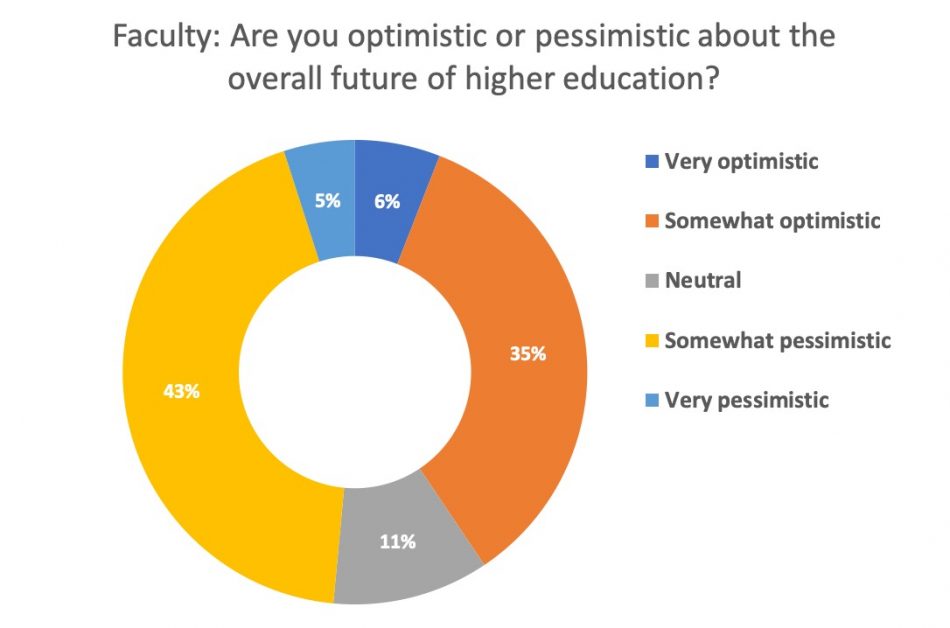
To address immediate health concerns around the COVID-19 pandemic, colleges and universities in Canada rapidly transitioned to online and blended learning options this spring, and they will largely remain online in the Fall of 2020. Short-term responses involved everything from revising instructional expectations to moving entire units online in a matter of days. But, what does the long term look like? While there are urgent and immediate concerns—such as preparing for a Fall semester that will remain largely online—what is on the horizon for higher education institutions in Canada?
As part of the Canadian Pulse Project, which is tracking the impact the COVID-19 pandemic is having on higher education institutions, we gathered data via a survey that asked administrators and faculty questions related to COVID-19 and higher education. In this essay, we provide a snapshot of 273 faculty and administrator perspectives on whether they are optimistic or pessimistic about the future of higher education over the next 2 years. We also asked them to provide their reasoning for their choice.
Overall, even in the midst of the pandemic, respondents are slightly more optimistic than pessimistic about the future of higher education over the next two years (see charts below). Results show a bi-modal distribution, indicating that respondents in both groups are either optimistic or pessimistic, with a few being neutral. Administrators are more optimistic than faculty (55 per cent vs. 41 per cent), and faculty reported being far more pessimistic than administrators (48 per cent vs. 22 per cent). The difference in perspective between the two groups may reflect local contexts and issues and necessitates further investigation. For instance, were there a greater number of faculty reporting from provinces with looming funding cuts? Were there greater numbers of administrators reporting from institutions well-situated to weather the pandemic and contribute to emerging skills gaps?


Frequently mentioned reasons for pessimism across the groups mostly centre around the compounding financial challenges the higher education sector is facing. Postsecondary funding cuts are expected to be exacerbated by institutional reliance on enrolment and student fees, particularly international student fees. Other concerns focus on the instability and uncertainty created by the crisis, impacting everything from workloads to planning to a lack of time to prepare for online teaching. Such concerns often extend to students and their ability to succeed and, at times, highlight the fact that the pandemic exacerbated inequities for particular students.
Frequently mentioned reasons for optimism across the groups centre around three areas. First, respondents highlighted the significant role higher education institutions play in times of crises. They note that higher education is vital for supporting economic recovery, essential for supporting changing societal needs, and can fill skills and knowledge gaps at a time of limited travel and work.
Second, respondents describe how the pandemic provides an opportunity for positive change. They report being optimistic about offering well-designed online courses, expanding the quality and access to online learning—especially the potential of drawing in a diversity of students who may not have been able to attend physical institutions—and increasing innovative teaching and learning practices. Finally, respondents note that the pandemic reveals not only the value of higher education, but also puts a spotlight on various issues in academia that need addressing.
Two quotes illustrate this area well. One respondent states that, “Despite government attempts to cut postsecondary education, I believe that our institutions are the very places that produce innovators, scientists, teachers, and others valued by society. It may be that changes come but I believe it is our responsibility to ensure future generations of learners have access to higher learning.” A second notes, “the current state [of postsecondary education] has shown that there is a need to be more learner-centered, more flexible, and nimble. This situation has identified the stodginess of higher education institutes.” While noting their optimism, a number of respondents also recognize that higher education will face challenges and difficulties in the near-term, but emphasize that “those who act with ingenuity and integrity will turn the crisis into unprecedented opportunity.”
The most interesting findings were the results of the following open-ended question inviting faculty members and administrators to speculate about the sector’s future: Imagine that it’s 2023 and COVID-19 is behind us. What do you think higher education looks like at that time?
We want to acknowledge that this is a difficult question to answer. One participant notes that it is “impossible to even guess” and one affably remarks that their “crystal ball is a bit cloudy.” Nonetheless, this question isn’t about predicting the future. Rather, it is about expanding the scope of the conversation beyond immediate needs and concerns.
Overwhelmingly, faculty and administrators expect more blended and online courses. Many note that these experiences will improve both the quantity and quality of online courses as institutions and faculty gain increased understanding and expertise in online learning and digital learning pedagogy. Some anticipate a “return to the prior normal.” Such feelings may be summed up in the following quote: “[Higher education will look] pretty much the same as before. There may be a few more online-only courses, but things change slowly in the postsecondary environment.”
Such changes are largely viewed in a positive light, and often as impetus to improve higher education overall. One individual sums it up this way: “Hopefully, we won’t go back to doing things the same way as before.” The post-coronavirus future described by these individuals is more flexible and provides greater access to education. It expands learning opportunities for larger segments of the population, supports learners and faculty, and abandons practices perceived to be outdated or ineffective—for example, “fewer big-box large lecture halls where someone is delivering information to hundreds at a time”.
Finally, the pessimistic future of higher education, as described by these individuals, includes “fewer institutions offering fewer programs to fewer international students and fewer domestic students.” Such a system is also described as including fewer faculty and slashed budgets.
One interpretation of these findings is that faculty and administrators appear to expect little change. Even in cases where individuals describe changes as “radical”—and they may indeed be radical in certain contexts, such as at universities that offered few online courses prior to the pandemic—the changes described overall seem incremental. One reason for this may be that 2023 is not that far away and higher education institutions are generally slow to change. Another possibility could be a bias towards the status quo and a belief that the pandemic is a temporary event with temporary ramifications. This could also explain both the optimistic opinions (comforted by the thought that higher education will return to normal) and also why the pessimistic opinions expressed—while negative—are not dystopian or harrowing.
These findings give us pause. While they reveal an early snapshot of participant beliefs, we believe that to survive this crisis—and other crises that are forthcoming, ranging from the impacts of climate change to expanding chasms in income inequality—faculty and administrators, with the support of governments, and in collaboration with students and other partners, should engage seriously with the idea that there may be a new and different future for higher education. In preparing for that future, we need to be asking “what should the future of higher education look like?” rather than “what does it look like?” and position ourselves as agents in making that future a reality.
Background to the research
Of the 14 total questions in the survey, 10 were displayed to faculty respondents and 13 to administrators. Since many academics have both teaching and administrative responsibilities, respondents were asked to select their primary role and were only presented with questions for that role.
Respondents included 273 higher education faculty and administrators from across Canada, with most of the responses coming from Ontario, Alberta, and British Columbia. All data were checked for completeness, missing values, or erroneous codes. Where appropriate, questions included an “other” response where the respondent could provide their own detailed answer. All responses entered as “other” were reviewed to determine if they should also be coded as one of the fixed responses.
The survey was a collaborative effort between Nicole Johnson (Canadian Digital Learning Research Association), George Veletsianos (Royal Roads University), Jeff Seaman (Bay View Analytics), and Academica Group. An invitation to participate in this study was included in the Academica Top Ten on April 24, April 28, and May 1, and survey data were gathered from April 24 through May 1. The survey was available in both English and French, but the majority of surveys were completed in English.
George Veletsianos is a Canada Research Chair in Innovative Learning and Technology and Professor in the School of Education and Technology at Royal Roads University; Nicole Johnson is the Director of the Canadian Digital Learning Research Association; and Jeff Seaman is the Co-Director of Bay View Analytics.









